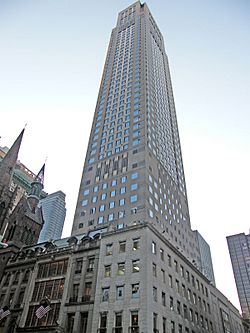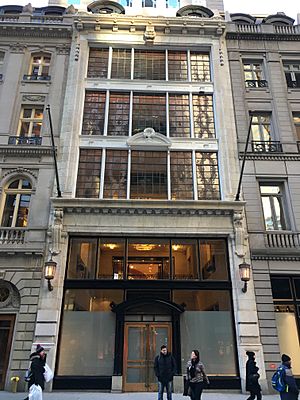712 Fifth Avenue facts for kids
Quick facts for kids 712 5th Avenue |
|
|---|---|
 |
|
| General information | |
| Status | Complete |
| Type | Office |
| Coordinates | 40°45′44″N 73°58′30″W / 40.7622°N 73.975°W |
| Construction started | 1987 |
| Completed | 1989 |
| Cost | $399 million |
| Owner | Bannister Trust |
| Management | Paramount Group |
| Height | |
| Roof | 650 ft (200 m) |
| Technical details | |
| Floor count | 52 |
| Floor area | 544,998 sq ft (50,632.0 m2) |
| Lifts/elevators | 11 |
| Design and construction | |
| Architect | SLCE Architects, Kohn Pedersen Fox Associates |
| Structural engineer | Severud Associates Consulting Engineers |
| References | |
| Designated: | January 29, 1985 |
| Reference #: | 1533 |
| Designated entity: | Rizzoli Building |
712 Fifth Avenue is a very tall skyscraper in New York City. It stands 650-foot-tall (200 m) at 56th Street and Fifth Avenue in Midtown Manhattan. The building was constructed from 1987 to 1990. It was designed by SLCE Architects and Kohn Pedersen Fox Associates.
What makes this tower special is how it was built. Its base includes the fronts of two older buildings. These are the Coty Building (built in 1871) and the Rizzoli Bookstore building (built in 1908). Both of these older parts are now protected as New York City landmarks. A famous store called Henri Bendel was located in the base from 1990 until 2018. When it was first finished, the skyscraper was mostly empty. However, it was later sold for a record price in 1999.
Contents
History of 712 Fifth Avenue
In the late 1800s, Fifth Avenue between 42nd Street and 59th Street was not very developed. The area where 712 Fifth Avenue now stands had a church and some brownstone houses. A brownstone house was built at 712 Fifth Avenue in 1886. By the early 1900s, this part of Fifth Avenue started to become a busy shopping area.
The Original 1908 Building
In 1907, plans were made for a new five-story building at 712 Fifth Avenue. This building, designed by Albert S. Gottlieb, replaced the old brownstone. It was finished in 1908 and looked similar to other homes built around that time.
The first tenant was L. Alavoine & Company, a company that decorated interiors. Other businesses also moved in, including Cartier, a famous jeweler. Many art galleries also had space on the first floor. The Fifth Avenue Presbyterian Church owned the building until 1959.
In 1963, Rizzoli Bookstore bought the building. They opened a store there the next year. Rizzoli also bought other nearby properties, creating a larger, L-shaped store. The bookstore became very popular. People loved its "marble floors, oak paneling, [and] sparkling chandeliers."
Building the Skyscraper
In 1983, a developer named David S. Solomon planned to build a new 44-story office skyscraper. He wanted to tear down the Rizzoli Building and the Coty Building next door. At that time, neither building was a protected landmark.
Solomon's company bought both buildings in 1984. They planned to demolish them. However, an expert noticed the unique windows of the Coty Building. These windows were designed by René Lalique, a famous French artist. This was his only known work in the United States. Also, real estate developer Donald Trump did not want the new skyscraper built. His own building, Trump Tower, was across Fifth Avenue, and the new tower would compete with it.
Because of this, a group called the Municipal Art Society asked the New York City Landmarks Preservation Commission to protect the buildings. On January 29, 1985, both the Coty and Rizzoli buildings were officially named landmarks. This stopped the skyscraper project for a while.
The developers then created a new plan. This plan, designed by Kohn Pedersen Fox, included a 650-foot (200 m) tower. It would have several setbacks, meaning parts of the building would be set back from the street. The Coty Building's special windows were restored in 1986. A two-story jewelry store at 716 Fifth Avenue was torn down. That same year, the luxury store Henri Bendel announced it would move its main store to the base of the new skyscraper.
The developers changed their plans again. The new design had straight walls instead of setbacks, which would make the upper floors larger. Construction began in 1987. The facades (fronts) of the landmark buildings were carefully restored. A new five-story facade was also built at 716 Fifth Avenue. To make space for the Henri Bendel store, the insides of the old buildings were removed. Only their outer walls were kept and connected to the new tower. The skyscraper was completed by 1989.
Recent History
In 1990, the original developers left the project. The Taubman Company took over. At first, the skyscraper was mostly empty. It was seen as a "white elephant," meaning it was very expensive but not very useful. By 1991, only a few tenants had moved in.
The building was finished just as a recession began in the early 1990s. However, things improved. In 1998, the building was sold for $285 million. This was a record price for office space at the time. By 2007, space in the building was in high demand. The Henri Bendel store closed its doors at the end of 2018.
Design of 712 Fifth Avenue
712 Fifth Avenue is 52 stories tall and has 11 elevators. It reaches a total height of 650 feet (200 m). The building was designed by Kohn Pedersen Fox and SLCE Architects. It has a special "Leadership in Energy and Environmental Design" (LEED) basic silver certification. This means it was built using environmentally friendly practices.
The skyscraper's base includes the three older structures: the Rizzoli Building, the Coty Building, and the facade at 716 Fifth Avenue. The main entrance is a classical-style loggia (a covered walkway) at ground level. The outside of the building is made of pearl-gray marble, gray limestone, and black granite.
The middle floors of the tower have many windows. The outer windows are set in pearl-gray marble. The windows in between are accented with black granite strips. The center windows are larger and set back slightly. At the very top, there are bronze decorations.
Inside, the building has 545,000 square feet (50,600 m2) of space. The upper floors have smaller areas, which are good for fashion companies and other special businesses. All the ground-level parts are connected inside. The Coty Building section has a four-story open space called an atrium.
The Rizzoli Building
The five-story Rizzoli Building was originally at 712 Fifth Avenue. It was designed in a French classical style. The building is about 120 feet (37 m) deep and has a limestone and brick front.
The front has three sections. On the ground floor, there was a door on the right. On the upper floors, the second floor had three tall, arched windows. The third and fourth floors looked like one unit, with columns separating the windows. The fifth floor is under a black slate mansard roof, which is a roof with four sloping sides.
The Coty Building
The six-story Coty Building at 714 Fifth Avenue was redesigned by Woodruff Leeming. Its design frames a large glass wall. The first two floors have limestone columns and a decorative ledge. The third through fifth floors are a wall of glass.
These glass windows were designed by René Lalique. They are his only known architectural work in the United States. The windows are separated by thin metal strips. The top floor has a decorative ledge with brackets supporting a railing. The sloped metal roof with arched windows helped the building fit in with its neighbors. Inside, there is a 5-story atrium with a balcony.
716 Fifth Avenue Facade
To the north of the Coty Building, a new five-story facade was built at 716 Fifth Avenue. It has a neoclassical style and is two sections wide. It looks similar to the Rizzoli Building's facade. However, its details are flatter, unlike the more detailed, three-dimensional look of the Rizzoli Building.
Tenants
Many different companies have offices in 712 Fifth Avenue, including:
- Aberdeen Asset Management
- Christian Dior
- CVC Capital Partners
- Riverstone Holdings
- Roberto Cavalli
- TSG Consumer Partners
- Vector Group
Images for kids
See also
 In Spanish: 712 Fifth Avenue para niños
In Spanish: 712 Fifth Avenue para niños





